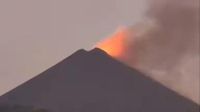South Asia's only active volcano, perched on the remote and uninhabited Barren Island in the Andaman Sea, has erupted twice within a week, setting off a flurry of scientific interest and social media buzz. The twin eruptions, recorded on September 13 and again on September 20, 2025, have drawn attention not only for their dramatic visuals—lava spewing from the crater and thick plumes of smoke billowing skyward—but also for their geological implications in one of the world's most seismically active regions.
Barren Island lies about 140 kilometers northeast of Port Blair, the capital of the Andaman and Nicobar Islands. This 8-square-kilometer landmass, rising 354 meters above sea level, sits at the convergence of the Indian and Burmese tectonic plates, on a fault line known as the West Andaman Fault. According to The Times of India and other regional outlets, the island is characterized by its stark volcanic cones, layers of ash, and sparse vegetation, a landscape shaped by centuries of intermittent eruptions.
What set these recent eruptions apart was not just their proximity in time, but their connection to seismic activity in the region. As reported by PTI and corroborated by The Times of India, the second eruption came just two days after a 4.2-magnitude earthquake rattled the Andaman Sea on September 18. Scientists say this is more than coincidence. O P Mishra, Director of the National Centre for Seismology, explained, "The eruption was caused by the shaking intensity inside the volcano’s magma chamber." He added that the chamber, located 18 to 20 kilometers beneath the surface, is regularly disturbed by seismic events in the area, setting the stage for these sudden outbursts of molten lava.
Barren Island's geological setting is key to understanding its volatility. The island straddles the West Andaman Fault, a zone where the Indian tectonic plate is slowly but persistently sliding beneath the Sunda Plate. This process generates frequent earthquakes—some minor, others more substantial—that send shockwaves deep into the earth. These tremors, according to officials cited by Moneycontrol, disrupt the magma chamber, forcing molten rock to the surface through cracks and fissures. In Mishra's words, "Shaking intensity in its magma chamber" is the direct cause of the eruptions.
Historical records maintained by the Andaman and Nicobar administration trace the first documented volcanic activity on Barren Island back to 1787. Since then, the volcano has maintained a pattern of intermittent, often unpredictable eruptions. Notable episodes were recorded in 1991, 2004, 2005, 2017, and 2022, each time following periods of heightened seismic activity. The 2004 event, in particular, occurred shortly after the devastating Indian Ocean tsunami, which itself was triggered by a massive undersea earthquake that shifted fault lines in the region.
The recent eruptions, while relatively small in scale, have reignited concerns about the delicate geological balance of the Andaman and Nicobar archipelago. As The Times of India noted, the islands are perched atop some of the most active fault lines on the planet. This makes them especially vulnerable to both earthquakes and volcanic disturbances. Experts warn that while the eruptions are typically short-lived, they are also notoriously unpredictable due to the constant motion of magma underground. Each seismic event brings with it the risk of another eruption, as accumulated heat and gases rush to escape through the island’s rocky vents.
Despite the spectacle, the eruptions have posed no immediate threat to human settlements. Barren Island is, after all, uninhabited—a fact that has spared local communities from direct harm. Still, the events have captured the imagination of the public and scientists alike. A video clip of the eruption, shared widely on social media by Sansad TV and others, showed fiery lava lighting up the night sky, prompting a flood of reactions. "The Planet is seething to the brim and it needed to let off steam," one user commented, while another mused, "Nature’s Help for India to Extend the Island for Maritime Trade Supremacy, without harming Nature Natural Land Base Increase." Others expressed concern for wildlife: "Pray all the animals, birds, and humans are safe and unharmed."
From a scientific perspective, the link between earthquakes and volcanic eruptions on Barren Island is now well established. According to Moneycontrol, every significant eruption in recent decades has followed seismic activity, underscoring a direct connection between the two phenomena. The volcano’s magma chamber, situated deep within the earth, is sensitive to the smallest of tremors. When these occur, they can rapidly accelerate the movement of molten rock, leading to sudden, explosive releases at the surface.
Interestingly, Barren Island is not the only volcano in the region, though it is the only one currently active. Narcondam, another volcanic island nearby, remains dormant for now. Scientists continue to monitor both sites closely, recognizing that the geological forces at play are both powerful and, at times, unpredictable.
The eruptions have also provided valuable data for researchers studying the region’s unique geology. According to officials, Barren Island’s volcanic activity offers a rare window into the processes that shape the earth’s crust in highly seismic zones. The island’s structure—rising nearly 2 kilometers from the sea floor and measuring about 3.2 kilometers in diameter—makes it an ideal natural laboratory for observing the interplay between tectonic shifts and volcanic behavior.
For local authorities, the priority remains vigilance. Although the recent eruptions were minor, officials are maintaining a close watch on seismic and volcanic activity in the area. With the islands’ history of both earthquakes and tsunamis, preparedness is more than a precaution—it’s a necessity. As one official noted, the events serve as a "reminder of the region’s susceptibility to natural hazards."
As the lava cools and the ash settles, Barren Island continues to stand as a testament to the restless forces beneath the earth’s surface. Its eruptions may be fleeting, but they are a stark reminder of the dynamic—and sometimes volatile—nature of the planet we call home.




